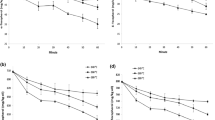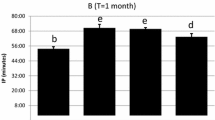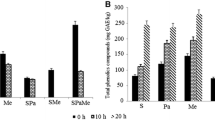Abstract
Thermal oxidative stability of red pepper (Capsicum annuum) seed oil added with different levels of capsaicin or tocopherol as antioxidant during heating up to 48 h at 140±5°C was studied. Lipid oxidation of soy and pepper oil with different levels of capsaicin (0.12, 0.24%) and tocopherol (0.3, 0.6%) were evaluated during storage at 1400C for 0, 12, 24 and 48 h by monitoring peroxide value (PV), thiobarbituric acid reactive substances (TBARS) and chemiluminiscence (CL). Capsaicin content of crude pepper oil (0.16 mg/ml) was much higher than that of commercial brands (0.004–0.02 mg/ml). Oleate content was significantly (p<0.05) higher in soy oil (53.7%) than pepper oil (9.5%), however, linoleate and linolenate contents were significantly (p<0.05) higher in pepper oil (70.6, 5.8%) than in soy oil (25.9, 5.8%). TBARS, PV, and CL of pepper oil were significantly (p<0.05) lower than soy oil after frying. TBARS and CL values of pepper oil with different levels of capsaicin or tocopherol showed significantly (p<0.05) lower values than untreated pepper oil during frying and storage. TBARS and CL values of 0.6% tocopherol treated pepper oil showed significantly (p<0.05) lower values than those of soy oil. The study suggests that capsaicin and tocopherol may play a key role to prevent the thermal oxidation of pepper oil during frying.
Similar content being viewed by others
References
AOCS (1998) Official methods and recommended practices. 5th edn, American Oil Chemists’ Society, Champaign, IL
Aoyama M, Maruyama T, Kanematsu H, Matsumoto (1986) Comparison of effects between the mixture of tocopherols and other antioxidants and synergists in the fryer test. Oil Chem 35: 449–453
Bligh EG, Dyer WJ (1959) A rapid method of total lipid extraction and purification. Canadian J Biochem Physiol 37:911–917
Carlson SE, Werkman SH (1996) A randomized trial of visual attention of preterm infants fed docosahexaenoic acid until two months. Lipids 31:85–90
Choi OS (1996) Emulsification stability of oleoresin red pepper and changes in antioxidant activity during thermal cooking. J Korean Soc Food Nutr 25:104–109
Choi YJ, Ko YS (1990) Studies on the lipid composition of red pepper seed oil. Int J Human Ecol 28:31–36
Cort WM (1974) Antioxidant activity of tocopherols, ascorbyl palmitate, ascorbic acid and their mode of action. J Am Oil Chem Soc 51:321–325
Husain SR, Cillard J, Cillard P (1987) Hydroxyl radical scavenging activity of flavonoids. PhytoChem 26:2489–2491
Kang MH, Song ES, Chung HK, Shim KB, Kang CW, Ryu YH, Lee JB (1995) Comparison of oxidation stability in sesame, corn and safflower oils. Korean J Int Agric 12:115–120
Kim JC, Lee JS (1980) The study on the refine and analysis of red pepper seed oil. Korean J Food Sci Technol 12:126–132
Kogure K, Goto S, Nishimura M, Yasumoto M, Abe K, Ohiwa C, Sassa H, Kusumi T, Terrada H (2002) Mechanism of potent antiperoxidative effect of capsaicin. Biochim Biophys Acta 47: 1700–1704
Lee KR (1977) Capsaicinoids content in the red pepper species. J Food Sci 6:21–25
Lee CH, Lee IH (2001) The effect of capsaicin on the thermal and oxidative stability of soybean oil. Animal Resources Res (Konkuk University) 22:9–17
Lee CH, Han KH, Kim AY, Lee SK, Hong GE, Pyun CW, Choi KD, Yang CY (2008) Effect of hot pepper seed oil, capsaicin and alpha-tocopherol on thermal oxidative stability in lard and soy bean oil. Korean J Food Sci Anim Resourc 28: 660–666
Miyazawa T, Fujimoto K, Kinoshita M, Usuki, R (1994) Rapid estimation of peroxide content of soybean oil by measuring thermoluminescence. J Am Oil Chem Soc 71: 343–345
Miyazawa T, Kikuchi M, Fuzimoto K, Endo Y, Cho SY, Kaneda T (1991) Shelf-life dating of fish meats in terms of oxidative rancidity measured by chemiluminescene. J Am Oil Chem Soc 68:39–43
Packer L (1991) Protective role of vitamin E in biological systems. Am J Clin Nutr 53:1050–1055
Speek AJ, Schrijver J, Schreuers WHP (1985) Vitamin E composition of some seed oils as determined by HPLC with fluorometric detection. J Food Sci 50:121–124
Tarladgis BG, Watts BM, Jounathane (1960) A distillation method for the quantitative determination of malonaldehyde in rancid food. J Am Oil Chem Soc 37:44–48
Author information
Authors and Affiliations
Corresponding author
Rights and permissions
About this article
Cite this article
Yang, CY., Mandal, P.K., Han, KH. et al. Capsaicin and tocopherol in red pepper seed oil enhances the thermal oxidative stability during frying. J Food Sci Technol 47, 162–165 (2010). https://doi.org/10.1007/s13197-010-0032-2
Revised:
Accepted:
Published:
Issue Date:
DOI: https://doi.org/10.1007/s13197-010-0032-2




